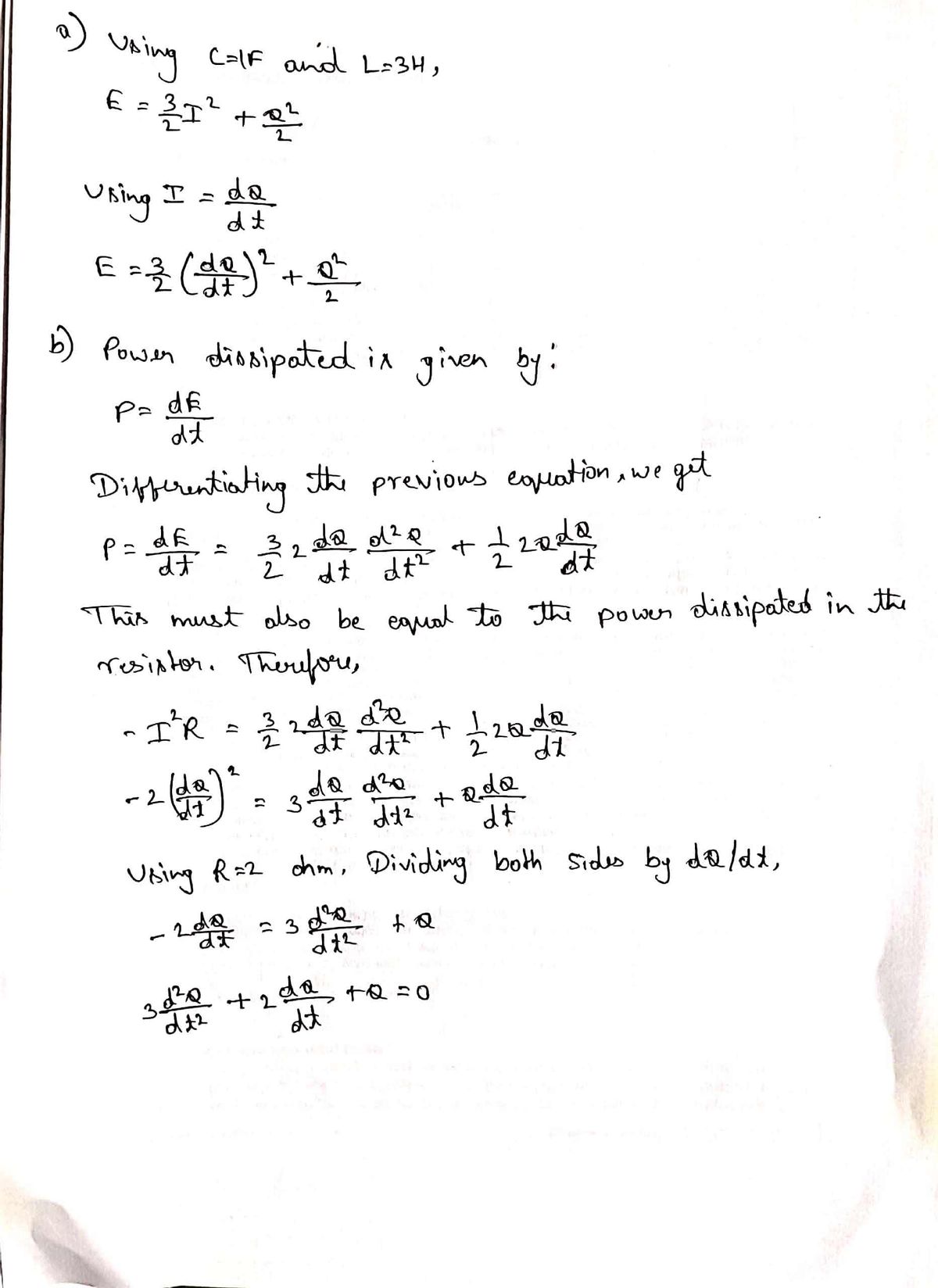3. You have seen how Kirchhoff's laws were used in your lectures to obtain a 2nd order differential equation where we solved for the current. This time we will use an even simpler concept: principle of conservation of energy to derive the 2nd order differential equation where we will solve for the charge. Take a look at the circuit below. IHE 2F In the circuit above, we have a capacitor with capacitance 2 F, an inductor of inductance 5 H and a resistor of 32 (a) The total energy that is supplied to the resistor is LI? + Q E = 20 where L is the inductance, I is the current, C is the capacitance and Q is the charge. Write down the total energy supplied E in terms of Q and t only. dQ Remember that I = dt (b) Now you know that the power dissipation through a resistor is -12R. Use the conservation of energy (energy gain rate = energy loss rate) to derive the differential equation in terms Q and t only. (c) Solve the differential equation for initial charge to be Qo with a initial current of -0.3Qo/s. (d) Given that the coefficient of your cosine function is the time-dependent amplitude (for example A(t) is the amplitude of the function A(t) cos t). At what time Thalf will the amplitude of the charge oscillations in the circuit be 50% of its initial value?
3. You have seen how Kirchhoff's laws were used in your lectures to obtain a 2nd order differential equation where we solved for the current. This time we will use an even simpler concept: principle of conservation of energy to derive the 2nd order differential equation where we will solve for the charge. Take a look at the circuit below. IHE 2F In the circuit above, we have a capacitor with capacitance 2 F, an inductor of inductance 5 H and a resistor of 32 (a) The total energy that is supplied to the resistor is LI? + Q E = 20 where L is the inductance, I is the current, C is the capacitance and Q is the charge. Write down the total energy supplied E in terms of Q and t only. dQ Remember that I = dt (b) Now you know that the power dissipation through a resistor is -12R. Use the conservation of energy (energy gain rate = energy loss rate) to derive the differential equation in terms Q and t only. (c) Solve the differential equation for initial charge to be Qo with a initial current of -0.3Qo/s. (d) Given that the coefficient of your cosine function is the time-dependent amplitude (for example A(t) is the amplitude of the function A(t) cos t). At what time Thalf will the amplitude of the charge oscillations in the circuit be 50% of its initial value?
Database System Concepts
7th Edition
ISBN:9780078022159
Author:Abraham Silberschatz Professor, Henry F. Korth, S. Sudarshan
Publisher:Abraham Silberschatz Professor, Henry F. Korth, S. Sudarshan
Chapter1: Introduction
Section: Chapter Questions
Problem 1PE
Related questions
Question
100%

Transcribed Image Text:3. You have seen how Kirchhoff's laws were used in your lectures to obtain a 2nd
order differential equation where we solved for the current. This time we will
use an even simpler concept: principle of conservation of energy to derive the
2nd order differential equation where we will solve for the charge. Take a look
at the circuit below.
IHE
2F
In the circuit above, we have a capacitor with capacitance 2 F, an inductor of
inductance 5 H and a resistor of 32
(a) The total energy that is supplied to the resistor is
LI?
E =
2
Q?
20
where L is the inductance, I is the current, C is the capacitance and Q
is the charge.
Write down the total energy supplied E in terms of Q and t only.
OP
Remember that I =
dt
(b) Now you know that the power dissipation through a resistor is -1R.
Use the conservation of energy (energy gain rate = energy loss rate) to
derive the differential equation in terms Q and t only.
(c) Solve the differential equation for initial charge to be Qo with a initial
current of -0.3Qo/s.
(d) Given that the coefficient of your cosine function is the time-dependent
amplitude (for example A(t) is the amplitude of the function A(t) cos t).
At what time Thalf will the amplitude of the charge oscillations in the
circuit be 50% of its initial value?
ll
Expert Solution
Step 1

Step by step
Solved in 2 steps with 3 images

Knowledge Booster
Learn more about
Need a deep-dive on the concept behind this application? Look no further. Learn more about this topic, computer-science and related others by exploring similar questions and additional content below.Recommended textbooks for you

Database System Concepts
Computer Science
ISBN:
9780078022159
Author:
Abraham Silberschatz Professor, Henry F. Korth, S. Sudarshan
Publisher:
McGraw-Hill Education

Starting Out with Python (4th Edition)
Computer Science
ISBN:
9780134444321
Author:
Tony Gaddis
Publisher:
PEARSON

Digital Fundamentals (11th Edition)
Computer Science
ISBN:
9780132737968
Author:
Thomas L. Floyd
Publisher:
PEARSON

Database System Concepts
Computer Science
ISBN:
9780078022159
Author:
Abraham Silberschatz Professor, Henry F. Korth, S. Sudarshan
Publisher:
McGraw-Hill Education

Starting Out with Python (4th Edition)
Computer Science
ISBN:
9780134444321
Author:
Tony Gaddis
Publisher:
PEARSON

Digital Fundamentals (11th Edition)
Computer Science
ISBN:
9780132737968
Author:
Thomas L. Floyd
Publisher:
PEARSON

C How to Program (8th Edition)
Computer Science
ISBN:
9780133976892
Author:
Paul J. Deitel, Harvey Deitel
Publisher:
PEARSON

Database Systems: Design, Implementation, & Manag…
Computer Science
ISBN:
9781337627900
Author:
Carlos Coronel, Steven Morris
Publisher:
Cengage Learning

Programmable Logic Controllers
Computer Science
ISBN:
9780073373843
Author:
Frank D. Petruzella
Publisher:
McGraw-Hill Education